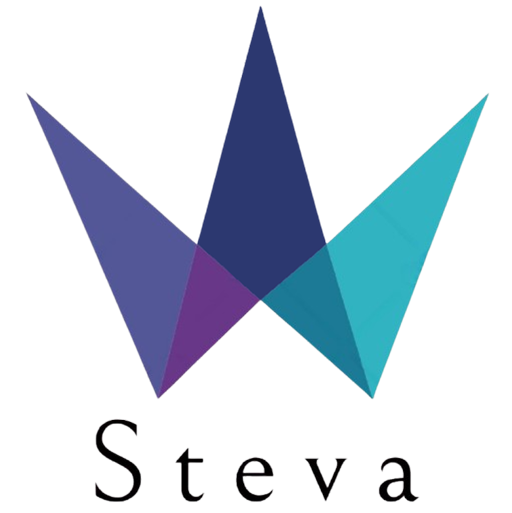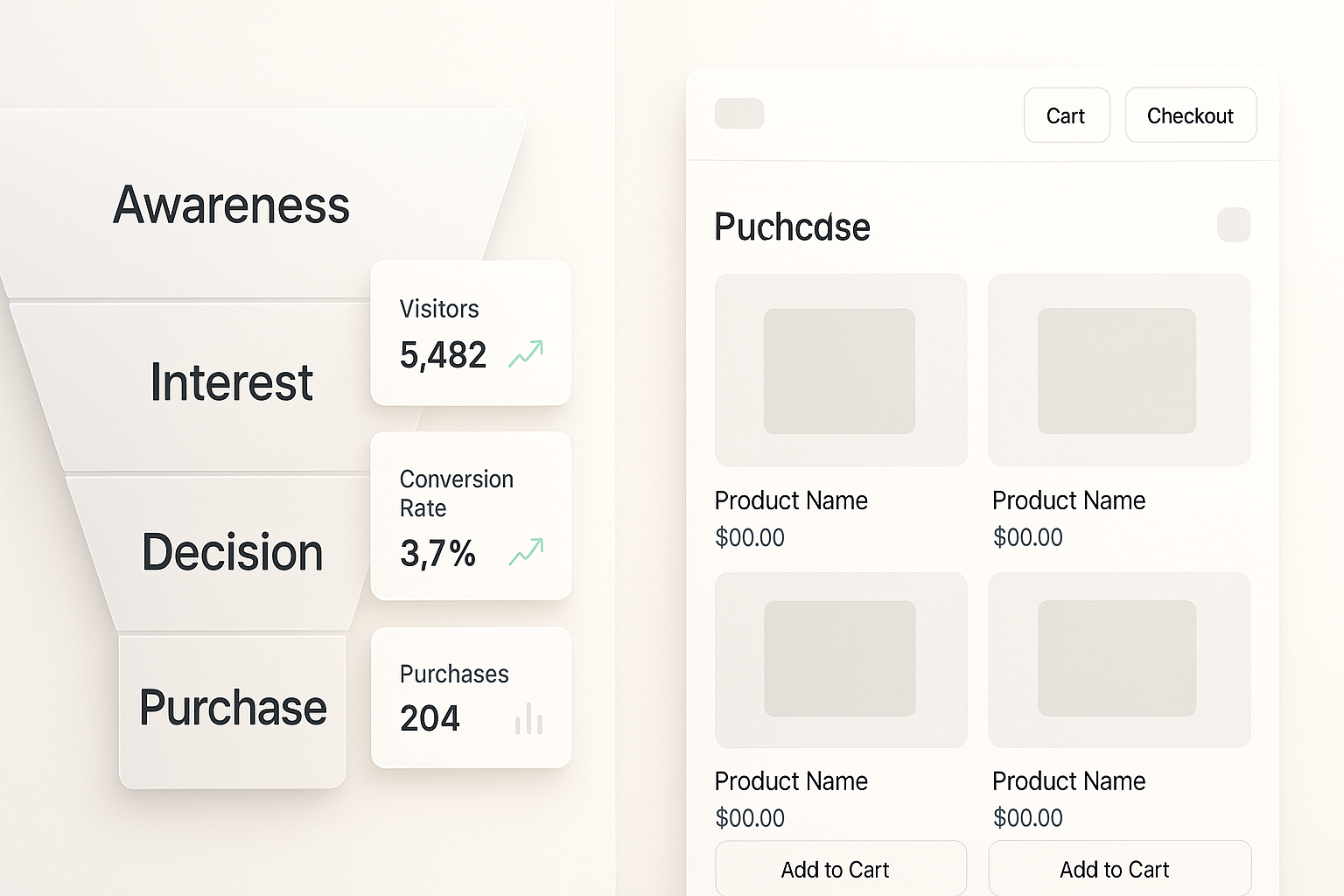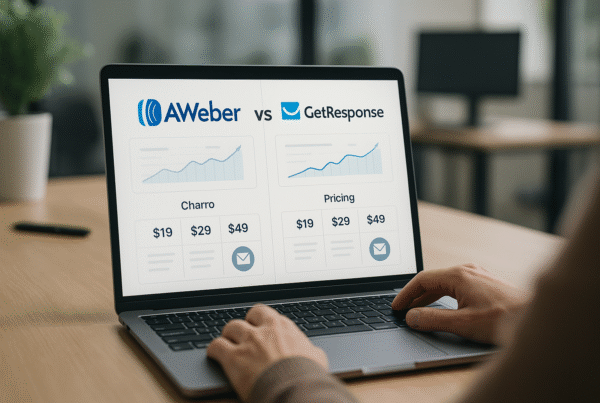When it comes to Clickfunnels vs Shopify, you’re looking at two powerful platforms with impressive reach. ClickFunnels has experienced significant growth, attracting 110,000 users worldwide who now utilize the platform to market and sell their products online. Meanwhile, Shopify has generated over $1 trillion in sales and powers more than 4.2 million online stores across 175 countries.
However, when comparing Shopify vs Clickfunnels 2.0, these platforms serve fundamentally different purposes. ClickFunnels excels in lead generation, conversion, and sales funnel optimization, making it a powerful tool for businesses that focus on these aspects. On the other hand, Shopify vs Clickfunnels represents a choice between Shopify’s comprehensive store management and scalability versus ClickFunnels’ marketing-first approach.
Whether you’re considering Clickfunnels vs Shopify dropshipping solutions or wondering which is better for your particular business model, the answer depends on your primary goals. Are you looking to maximize conversions through strategic funnel design, or do you need a complete e-commerce solution to manage an extensive product offering? In this guide, we’ll break down exactly how these platforms compare, so you can make the right choice to maximize your online sales potential.
Platform Purpose and Core Differences
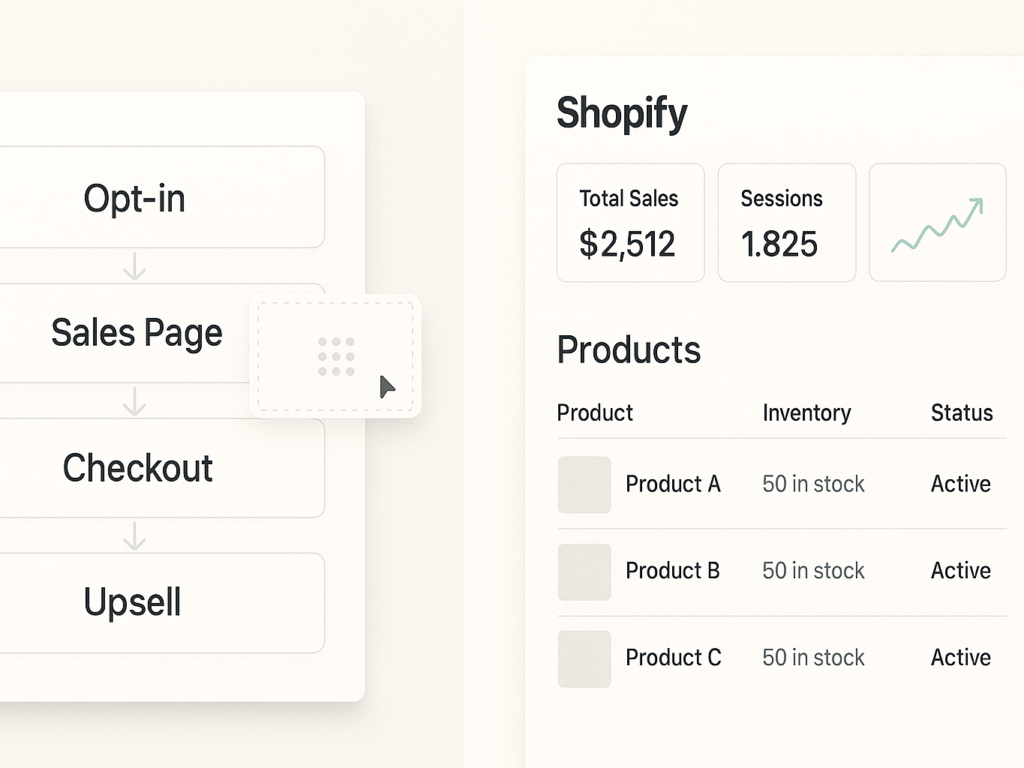
Understanding the fundamental differences between ClickFunnels and Shopify begins with recognizing their distinct purposes. These platforms were built to solve completely different business challenges, which explains their contrasting approaches to online sales.
1. ClickFunnels: Funnel-first approach for conversions
ClickFunnels emerged in 2014 as a platform specifically designed to help businesses create and optimize sales funnels. Unlike traditional website builders, ClickFunnels focuses entirely on maximizing conversions through strategic funnel design and automation. Understanding what ClickFunnels truly offers reveals how the platform views funnels not merely as features but as a comprehensive mindset for business growth.
At its core, ClickFunnels operates on the principle that guided customer journeys yield better results than traditional websites. Your funnel works like your best salesperson, leading prospects through carefully crafted steps that build trust and showcase value without requiring hard selling. Once built, these funnels operate continuously, attracting leads and converting them into customers around the clock.
The platform excels in:
- Advanced funnel creation tools with drag-and-drop functionality
- Split testing capabilities for optimization
- One-click upsells and downsells to maximize customer value
- Email marketing integration for follow-up sequences
- 14+ ready-made funnel templates for various business needs
This conversion-focused approach makes ClickFunnels particularly effective for businesses selling individual products or digital goods where the marketing funnel is the primary driver of success.
2. Shopify: Store-first approach for product management
In contrast, Shopify was founded in 2006 by Tobias Lütke, who needed a platform to sell snowboards online. From its inception, Shopify has focused exclusively on helping merchants sell products efficiently. This store-first approach prioritizes comprehensive product management, inventory control, and multi-channel selling capabilities.
Shopify’s strength lies in its robust e-commerce infrastructure, offering:
- Comprehensive inventory management with item tracking
- Low stock alerts and sales monitoring tools
- Multi-channel selling across social media and marketplaces
- POS integration for seamless online/offline sales
- Global commerce capabilities with multi-currency support
While Shopify lacks built-in funnel-building tools, it offers many components that support effective sales processes. These include blog creation for inbound marketing, attractive product pages with multimedia support, targeted email campaigns, and time-limited discount codes, all designed to generate interest and drive purchases.
3. When to use ClickFunnels vs Shopify
When deciding between Clickfunnels and Shopify, your choice should align with your specific business model and sales strategy.
(i) Choose ClickFunnels if you have:
- A single product or a limited catalog (fewer than 20 products)
- Digital products like ebooks, courses, or software
- Complex sales funnels requiring upsells, downsells, and order bumps
- Coaching or consultation services need to lead nurturing
- Affiliate marketing is a key revenue channel
- Webinar-based selling models
- A focus on lead generation and conversion optimization
(ii) Choose Shopify if you need:
- Management for extensive product catalogs
- Physical product selling with shipping integration
- Scalability for significant business growth
- Integrated multi-channel selling options
- International commerce with multiple currencies
- Brand-focused store experience
- Advanced e-commerce analytics
- Subscription-based business models
- Dropshipping capabilities with dedicated apps
- Omnichannel retail with in-store POS integration
Additionally, many businesses find value in combining both platforms: using Shopify for comprehensive store management and ClickFunnels for targeted, high-conversion marketing campaigns. This integration enables you to leverage the strengths of each platform as your business needs evolve.
What is ClickFunnels? The Truth About This $160M Sales Platform: Before diving deeper into comparisons, it’s essential to understand ClickFunnels’ core functionality. This comprehensive guide reveals how this $160 million platform works, its real-world performance metrics, and whether it lives up to the marketing hype for different business types. Learn more about ClickFunnels.
Sales Funnel Capabilities and Conversion Tools
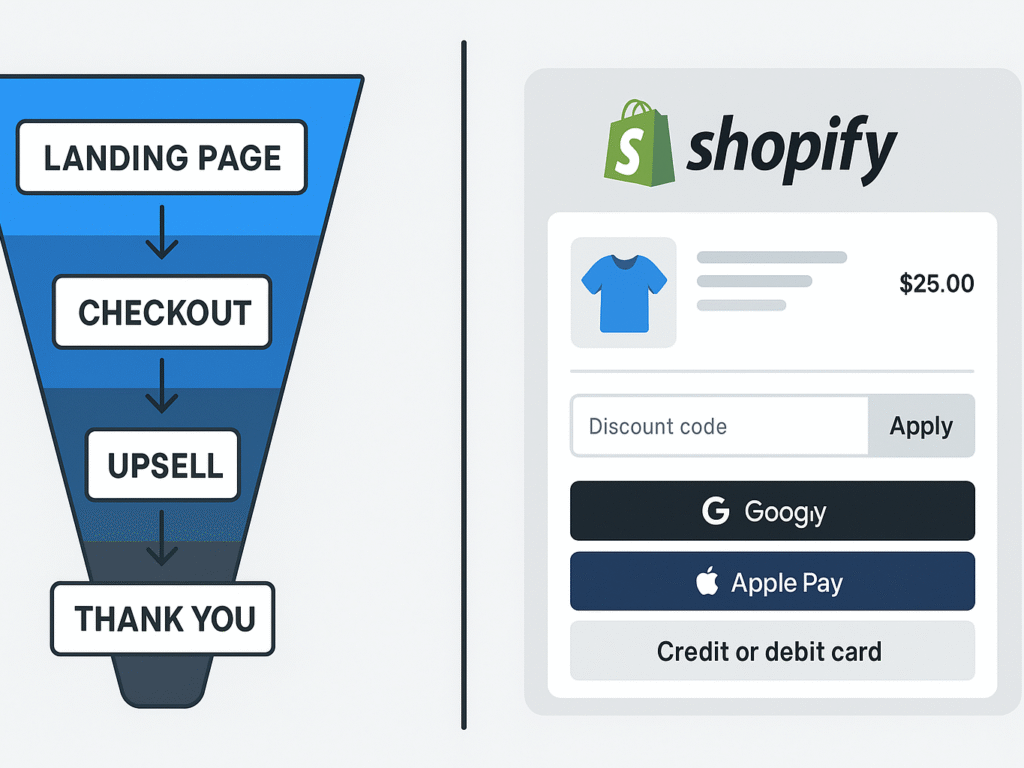
The battle between ClickFunnels and Shopify becomes most apparent when examining their sales funnel capabilities, the very tools that turn visitors into buyers.
1. Funnel Templates: 14+ vs App-based funnel builders
ClickFunnels offers a comprehensive set of 14+ ready-made funnel templates tailored for various marketing scenarios. These include opt-in, webinar, sales, and membership funnels. Each template comes with multiple style variations and can be customized using the drag-and-drop editor, eliminating the need for coding knowledge.
Conversely, Shopify offers no dedicated funnel-building features out of the box. Creating similar functionality requires purchasing third-party apps from Shopify’s app store. Popular options include ConvertFlow (starting at $99/month) and PageFly Landing Page Builder (starting at $24/month). Although Shopify lacks native funnel builders, it does offer many components that support effective sales processes, such as blog creation for inbound marketing and attractive product pages.
2. A/B Testing: Built-in vs third-party apps
ClickFunnels excels with integrated split testing functionality for any page within your sales funnel. Users can easily duplicate an existing page or create new variants from scratch. The platform automatically directs specified traffic to each version, enabling real-time performance comparisons. This built-in testing capability makes continuous optimization straightforward.
For Shopify users, A/B testing requires additional third-party apps, such as ConvertFlow or Intelligems, both of which start at $99/month. It represents a significant investment beyond Shopify’s base subscription cost.
3. Upsells and Downsells: Native vs plugin-based
Furthermore, ClickFunnels offers native implementation of one-click upsells, downsells, and order bumps. These features are automatically activated after purchase, creating seamless opportunities to increase the average order value by 10-30%. The classic cart funnel structure includes a sales page, an upsell, a cross-sell, and a thank-you page.
Meanwhile, Shopify requires multiple third-party apps to approximate similar functionality, often at considerable additional cost. Even then, Shopify’s rigid checkout process (which cannot be modified without upgrading to Shopify Plus) limits the ability to create seamless conversion paths.
4. Clickfunnels vs Shopify conversion rate comparison
Regarding the ClickFunnels vs Shopify conversion rate comparison, ClickFunnels typically reports higher rates due to its focus on funnel optimization. Users usually see conversion rates of 1-5%, with top performers achieving rates of 10% or higher. The platform’s specialized funnel-building capabilities give it an advantage for conversion-focused businesses.
Shopify’s standard conversion rate typically ranges from 1% to 3% across most stores. Although these rates can be improved with apps and optimizations, achieving ClickFunnels’ conversion power requires significant additional setup. Nevertheless, Shopify’s detailed analytics help identify and address conversion roadblocks effectively.
Ecommerce Features and Store Management
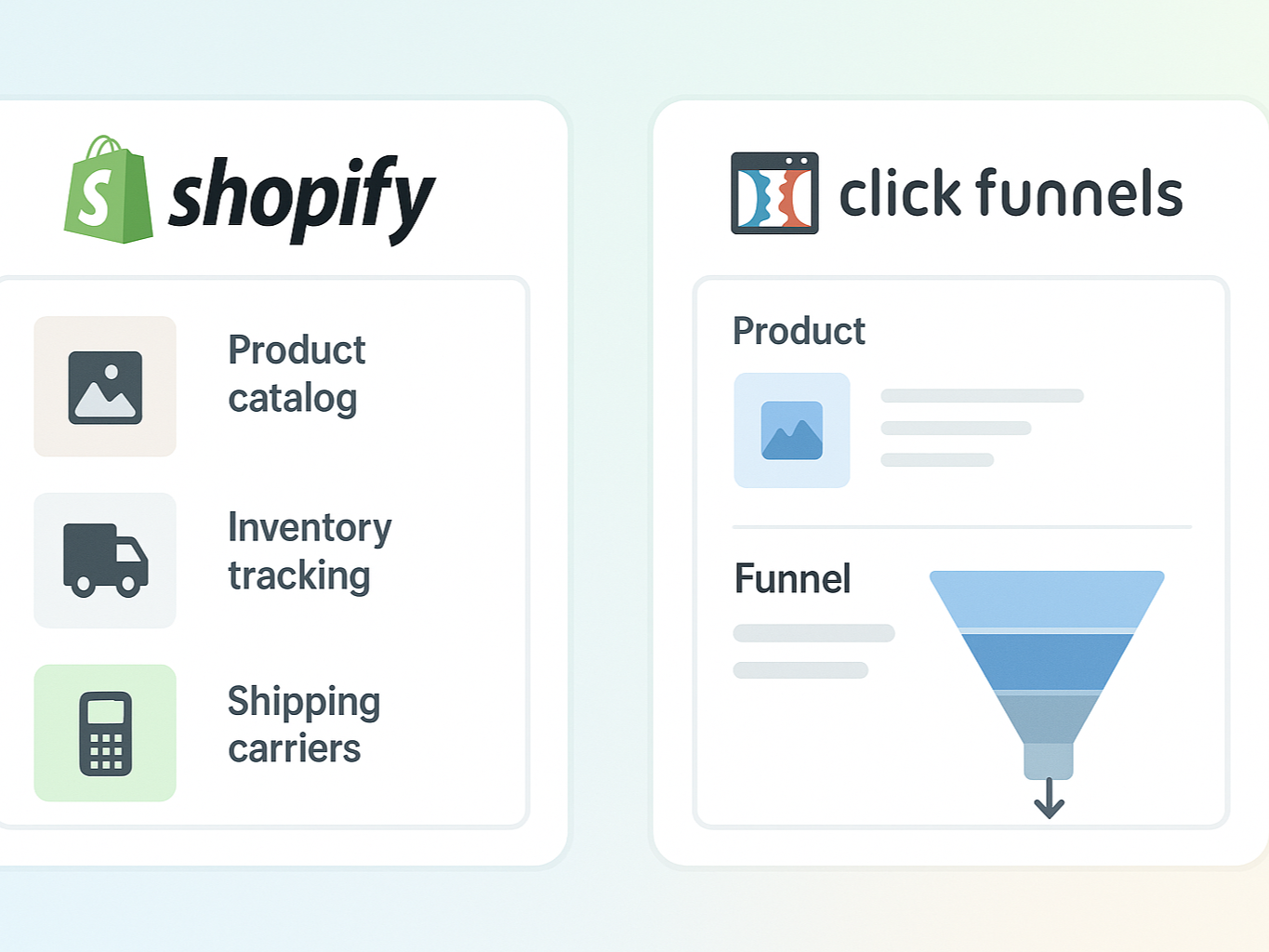
Beyond conversion tools, store management capabilities reveal fundamental differences in how ClickFunnels and Shopify handle product sales and inventory.
1. Product Variants: 343 vs 100 (soon 2000)
When selling products with multiple options, such as size, color, or material, variant limits become crucial. Notably, ClickFunnels allows each product to have three options, each with up to seven attributes, enabling 343 possible variants per product. Shopify currently limits merchants to three product options, with a maximum of 100 variants in total, regardless of the number of values per option.
Fortunately for Shopify users, this limit is scheduled to increase dramatically to 2,000 variants in 2025. Until then, merchants with extensive product options might find ClickFunnels more accommodating, even as Shopify offers third-party apps to overcome these limitations.
2. Digital Products: 3GB vs 5GB file size
In terms of selling downloadable content, such as ebooks or music, both platforms effectively support digital product sales. Shopify demonstrates greater generosity with file sizes, permitting uploads of up to 5GB per digital product. ClickFunnels limits uploads to files up to 3 GB. Moreover, setting up digital products in ClickFunnels requires more steps than Shopify’s streamlined process.
3. Shipping and Fulfillment: Basic vs Advanced
Regarding order fulfillment, the platforms differ substantially. ClickFunnels provides basic shipping management in its dashboard, allowing merchants to set general rates, create shipping profiles, and define shipping zones. Shopify excels with comprehensive shipping features, including:
- Discounted carrier rates (up to 88%) from USPS, UPS, DHL, and others
- Real-time carrier-calculated shipping rates at checkout
- Free shipping insurance up to $200 per shipment
- Integration with 500+ shipping-related apps
4. POS and In-person Sales: Absent vs Shopify POS
For physical retail integration, Shopify is the dominant choice. ClickFunnels does not offer built-in point-of-sale functionality, requiring third-party tools and complex integrations for in-person sales. Conversely, Shopify provides its own dedicated POS app bundled with all plans through “Shopify POS Lite”. It includes payment processing, inventory tracking, and receipt generation. Advanced POS features are available through the “POS Pro” add-on for $89 per month per location.
5. ClickFunnels vs Shopify dropshipping capabilities
Ultimately, Shopify stands out as the premier solution for dropshipping. The platform offers seamless integrations with over 650 dropshipping apps and 590 print-on-demand services. These connections automate order processing and simplify supplier management. ClickFunnels technically supports dropshipping but lacks direct integrations with major fulfillment platforms, making the process considerably more challenging. Merchants must rely on workarounds, such as Zapier or custom integrations, to connect ClickFunnels with their suppliers.
How to Design a Shopify Store (and 7 Mistakes to Avoid in 2025): Store design significantly impacts conversion rates and customer experience. This detailed guide covers essential design principles, common pitfalls that hurt sales, and proven strategies for creating high-converting Shopify stores that outperform competitors in your niche. Get the complete guide.
Marketing, SEO, and Automation Tools
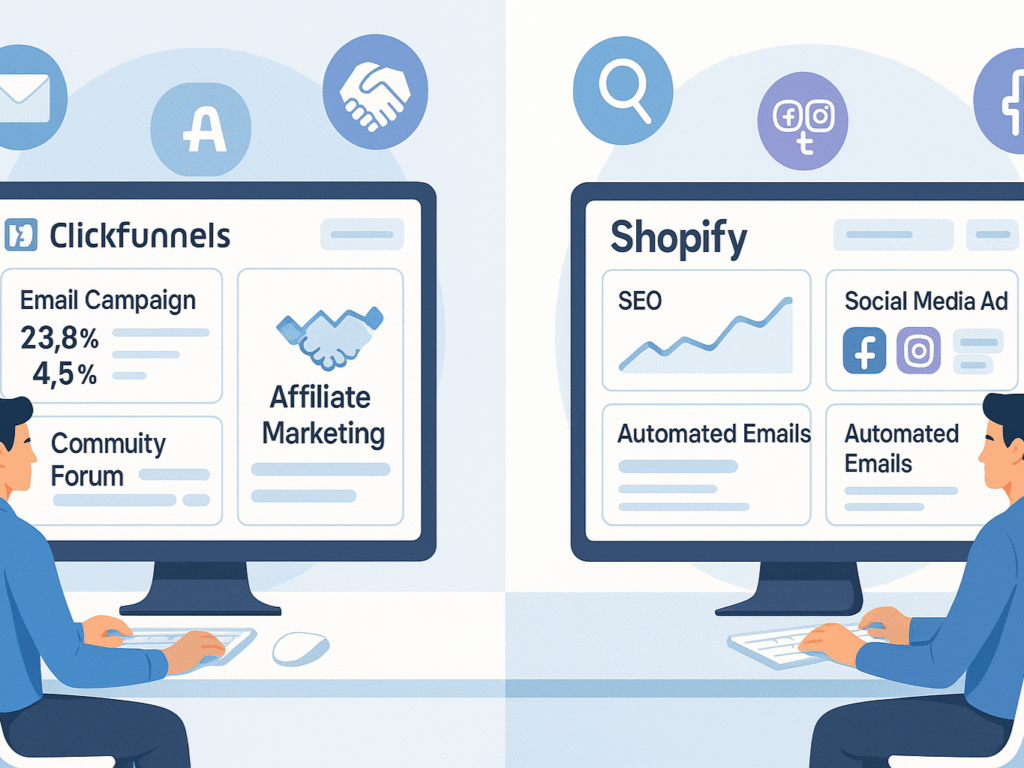
Successful online businesses require practical marketing tools beyond their sales platforms. First, let’s examine how ClickFunnels and Shopify approach these essential marketing capabilities.
1. Email Marketing: 10K free vs $0.67 per 1K emails
Both platforms offer email marketing tools, yet their pricing models differ significantly. With Shopify Email, you receive 10,000 emails per month free of charge. After reaching this threshold, you pay $1.00 per 1,000 additional emails sent. In contrast, ClickFunnels charges $0.67 per 1,000 emails sent through its marketing tool. This pricing difference means sending 10,000 monthly emails costs nothing with Shopify but $6.75 with ClickFunnels.
2. SEO Tools: Core Web Vitals and app support
Regarding search engine optimization, basic tasks like editing meta descriptions and adding alt text are straightforward on both platforms. Nonetheless, Shopify outperforms with its SEO toolkit. It automatically generates sitemaps, offers robust image optimization, and allows integration of schema markup. ClickFunnels provides only basic SEO features, primarily meta titles and descriptions customization. Shopify further distinguishes itself with Core Web Vitals reports and numerous specialized SEO apps in its store.
3. Affiliate and Community Tools: Built-in vs app-based
ClickFunnels excels with its built-in affiliate marketing system that enables business owners to create unique affiliate links and manage commission structures. This native functionality makes implementing affiliate programs substantially easier than with Shopify, which requires third-party applications, such as the Affiliate app by Secomapp.
ClickFunnels also offers a dedicated “Community Space” tool, essentially a forum builder allowing sellers to develop engaged digital communities. This feature proves especially valuable for businesses selling courses or membership content. Shopify users must install additional community management apps, such as ‘Shopical’ or ‘HouseParty’, which involve extra costs and setup time.
4. Social Media Integration: Native vs App-based
Shopify emphasizes selling through social media ads and offers direct integrations with major platforms. The platform’s mobile apps (Shopify and Shopify POS) enable merchants to manage store functions from anywhere. ClickFunnels integrates seamlessly with popular email marketing platforms, such as Mailchimp and AWeber, with a focus on email marketing campaigns rather than social selling. For extensive social media marketing, Shopify’s app ecosystem typically provides more comprehensive options.
ActiveCampaign vs. ClickFunnels: Real Differences Small Businesses Need to Know: Email marketing integration is crucial for long-term success. This comparison reveals which platform better serves small businesses, examining automation capabilities, pricing structures, and real-world performance metrics to help you choose the right marketing stack. Compare marketing platforms
Design, Templates, and Customization
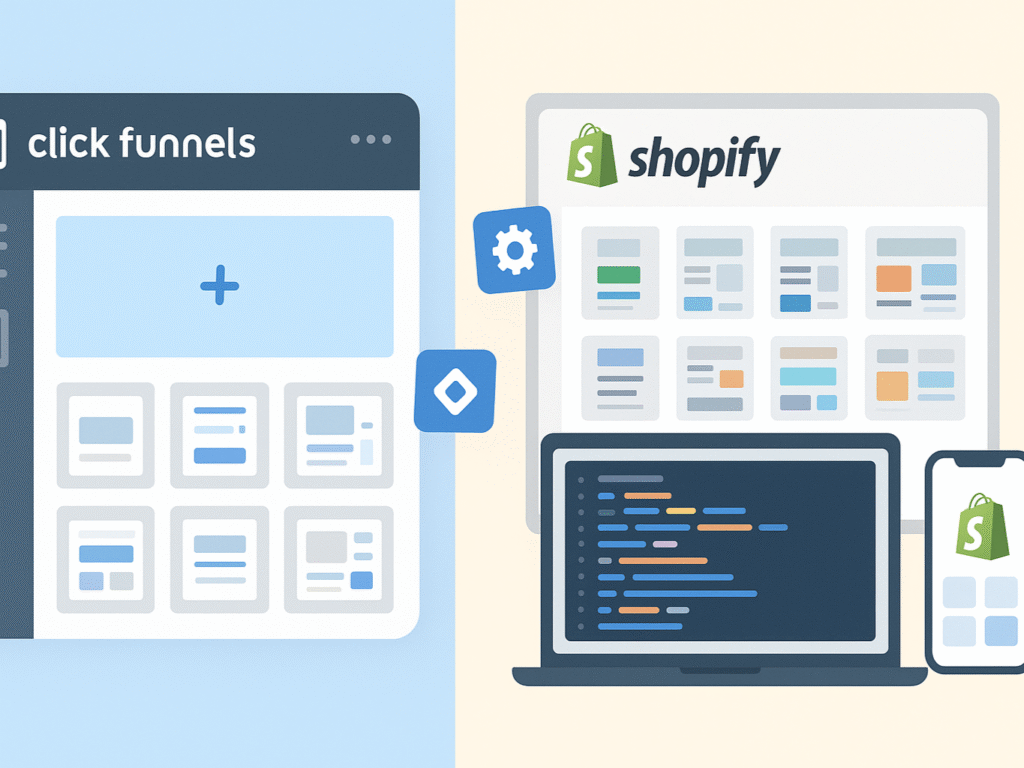
Design aesthetics and customization options significantly impact user experience and brand presentation. When comparing ClickFunnels vs Shopify, both platforms offer distinct approaches to visual design, ranging from template variety to customization depth, which directly influence conversion rates and customer engagement.
1. Template Variety: 8 vs 250+ themes
ClickFunnels provides approximately eight core themes with various style variations, focusing primarily on conversion-optimized designs. While some designs are of high quality, many are lazy and lack variety, limiting creative flexibility for businesses seeking unique brand presentations across different industries.
Shopify offers more than 70 nicely designed themes natively, with over 800 free and paid themes available when including third-party providers like ThemeForest. This extensive selection spans industries from fashion to electronics, offering merchants a comprehensive range of design options. Learning how to design a Shopify store effectively can significantly impact conversion rates and customer experience across different business niches and target audiences.
2. Customization Flexibility: Drag-and-drop vs Liquid code
ClickFunnels emphasizes user-friendly customization through its drag-and-drop editor, enabling non-technical users to modify layouts, colors, and content without coding. However, entrepreneurs exploring alternatives often compare Pipeline Pro with ClickFunnels for their funnel-building capabilities and conversion optimization features, which suit their specific business requirements. This approach prioritizes speed and simplicity for marketing-focused businesses.
- Visual page builder with pre-designed elements
- Real-time preview during the customization process
- Limited advanced customization without coding skills
Shopify utilizes the Liquid templating language for in-depth customization, allowing developers to create highly personalized store experiences. While it requires technical expertise, this approach offers unlimited design possibilities and sophisticated functionality integration for growing businesses.
3. Mobile App Availability: None vs Full suite
ClickFunnels lacks dedicated mobile apps, forcing users to access the platform exclusively via web browsers. This limitation affects productivity for entrepreneurs managing campaigns while traveling or working remotely, particularly impacting real-time funnel monitoring and quick adjustments.
Shopify offers comprehensive mobile applications, including the main Shopify app and Shopify POS, designed for retail integration. These apps enable merchants to manage inventory, process orders, track analytics, and handle customer service from anywhere, significantly enhancing operational flexibility.
The mobile capability gap becomes crucial for businesses that require constant oversight and quick responses to market changes. Shopify’s mobile ecosystem supports omnichannel commerce strategies, whereas ClickFunnels users remain desktop-dependent for campaign management and optimization.
Pipeline Pro Vs. ClickFunnels [2025]: One Clear Winner For Sales Funnels: Considering funnel-building alternatives? This detailed comparison examines Pipeline Pro versus ClickFunnels, analyzing features, pricing, ease of use, and conversion capabilities to determine which platform delivers better ROI for sales funnel creation and optimization. See the winner
Sales and Marketing Performance
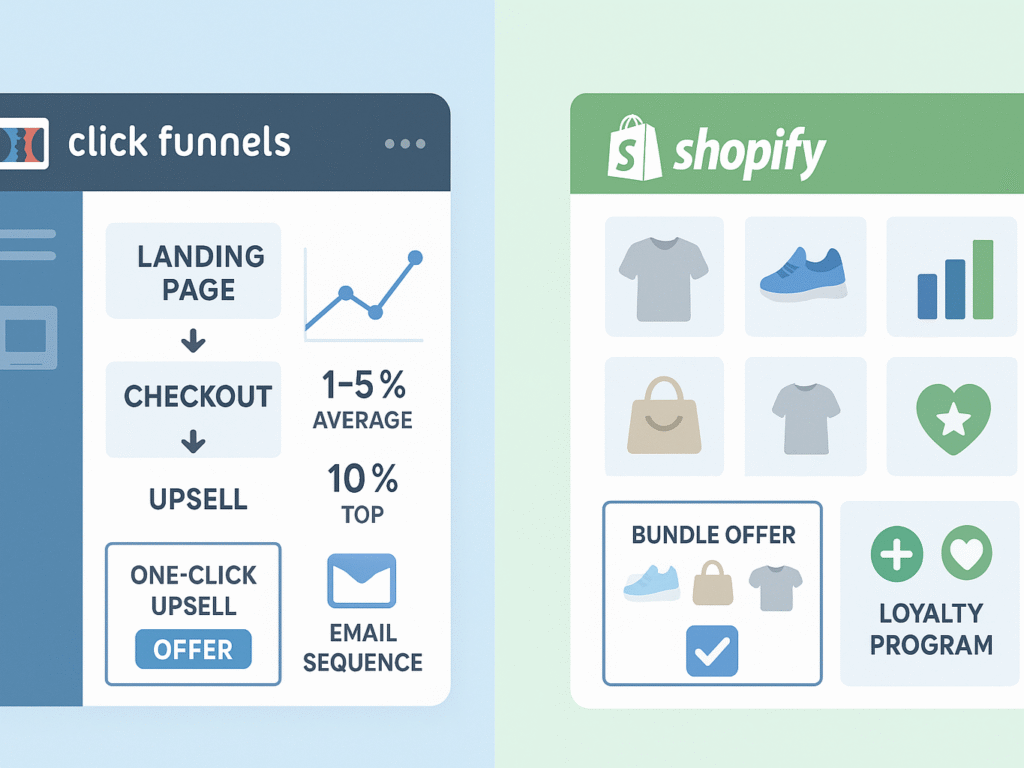
Performance metrics determine a platform’s effectiveness in generating revenue. Both ClickFunnels and Shopify excel in different areas: ClickFunnels focuses on funnel optimization, while Shopify focuses on comprehensive store management.
1. Conversion Rate Optimization: Funnels vs Stores
When examining ClickFunnels’ conversion rate performance, ClickFunnels specializes in conversion optimization through strategically designed sales funnels, typically achieving conversion rates of 1-5%, with top performers reaching 10% or higher. The platform’s funnel-first approach guides prospects through carefully crafted customer journeys.
- Built-in A/B testing for continuous optimization
- One-click upsells and downsells integration
- Conversion-focused page templates and elements
Shopify’s standard conversion rates typically range from 1% to 3% for most stores, requiring additional apps and optimizations to match ClickFunnels’ performance. However, detailed analytics help identify conversion roadblocks effectively for systematic improvements.
The ClickFunnels vs Shopify conversion rate analysis reveals ClickFunnels’ advantage in conversion-focused scenarios. At the same time, Shopify excels in comprehensive store management, offering scalable growth potential through its extensive app ecosystem and analytics capabilities.
2. Average Order Value: Upsells vs Bundles
ClickFunnels’ native upsell and downsell features automatically increase average order value by 10-30% through seamless post-purchase offers. The platform’s funnel structure naturally incorporates order bumps and cross-sells within the checkout process.
- One-click upsell implementation without coding.
- Order bumps are integrated into sales pages.
- Automated downsell sequences for declined offers.
Shopify requires third-party applications to achieve similar upselling functionality, often at an additional monthly cost and with complex setup.
- Product bundling apps for package deals
- Recommendation engines based on purchase history
- Loyalty program integration for repeat purchases
ClickFunnels vs Shopify dropshipping analysis highlights ClickFunnels’ built-in advantages for upselling and cross-selling. At the same time, Shopify’s extensive app ecosystem offers more sophisticated, long-term customer value-optimization strategies through comprehensive analytics and segmentation tools.
3. Customer Retention: Email Sequences vs Loyalty Programs
ClickFunnels includes automated email marketing sequences designed for lead nurturing and customer retention at $0.67 per 1,000 emails. These sequences integrate seamlessly with sales funnels for consistent follow-up communication. For businesses requiring more advanced marketing automation, comparing ActiveCampaign vs ClickFunnels reveals important integration considerations and email marketing capabilities.
Shopify Email offers 10,000 free monthly emails, followed by a $1.00 charge per 1,000 additional emails. The platform focuses on transactional emails and promotional campaigns rather than comprehensive funnel-based sequences.
- Automated abandoned cart recovery emails
- Post-purchase follow-up sequences
- Customer segmentation for targeted messaging
- Integration with loyalty and rewards programs
The Shopify vs ClickFunnels 2.0 comparison reveals that ClickFunnels excels in automated marketing sequences. In contrast, Shopify excels in comprehensive customer retention through loyalty programs, detailed customer analytics, and personalized shopping experiences that encourage repeat purchases and foster brand loyalty.
Integrations, Payments, and Global Selling
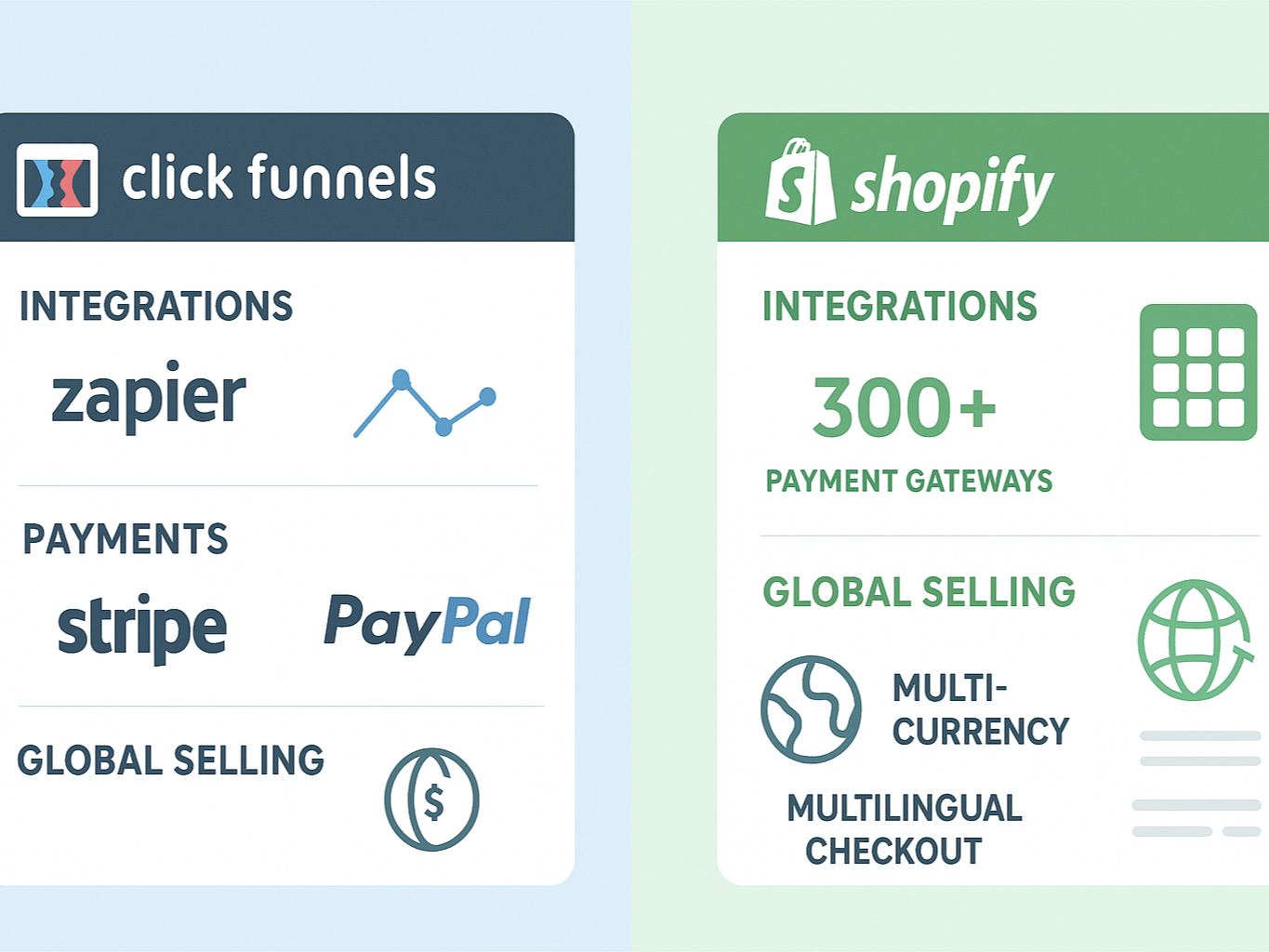
International commerce capabilities and payment processing flexibility determine a platform’s suitability for scaling businesses. Integration options have a significant impact on operational efficiency and customer experience across various markets.
1. Payment Gateways: 5+ vs 300+ options
ClickFunnels supports major payment processors, including Stripe, PayPal, and its proprietary Payments AI system, which covers essential payment methods for most businesses. However, the limited selection may restrict merchants in specific regions or industries.
Shopify integrates with over 300 payment gateways globally, accommodating diverse customer preferences and regional requirements. This extensive network includes local payment methods, digital wallets, and emerging fintech solutions, ensuring maximum conversion rate optimization across international markets.
2. Multi-currency and Multilingual: Manual vs Shopify Markets
ClickFunnels requires manual setup for international sales, which limits its global expansion capabilities. Merchants must configure separate funnels for each region and manually manage currency conversions and localization.
- Manual currency conversion setup required
- Limited localization features for international markets
- Separate funnel creation for different regions
- No native multi-language support
- Third-party tools needed for global scaling
Shopify Markets provides comprehensive international selling features that automatically handle currency conversion, tax calculations, and localized checkout experiences. This native functionality significantly reduces complexity for businesses expanding internationally.
3. Third-party Integrations: Zapier vs Native apps
ClickFunnels relies heavily on Zapier for third-party integrations, with approximately 20 native app connections available. This approach requires additional subscriptions and a complex automation setup for comprehensive business tool connectivity.
Shopify’s app ecosystem comprises over 16,000 applications that cover every business need, from inventory management to customer service and support. Native integrations eliminate additional subscription costs and provide seamless functionality. For content creators specifically, examining the differences between Stan Store and Shopify reveals platform-specific variations in audience monetization and digital product sales strategies.
The ClickFunnels vs Shopify comparison for integrations favors Shopify’s extensive native ecosystem. While ClickFunnels excels in funnel-specific features, Shopify provides comprehensive business tool integration supporting complex operational requirements and scalable growth strategies.
Stan Store vs Shopify: Which Is Best for Creators in 2025? Content creators have unique needs that differ from traditional e-commerce. This comparison examines Stan Store vs. Shopify for creators, analyzing key features such as link-in-bio functionality, digital product sales, and audience monetization to determine which platform best suits your creative business. Creator platform comparison
Pricing, Scalability, and App Ecosystem
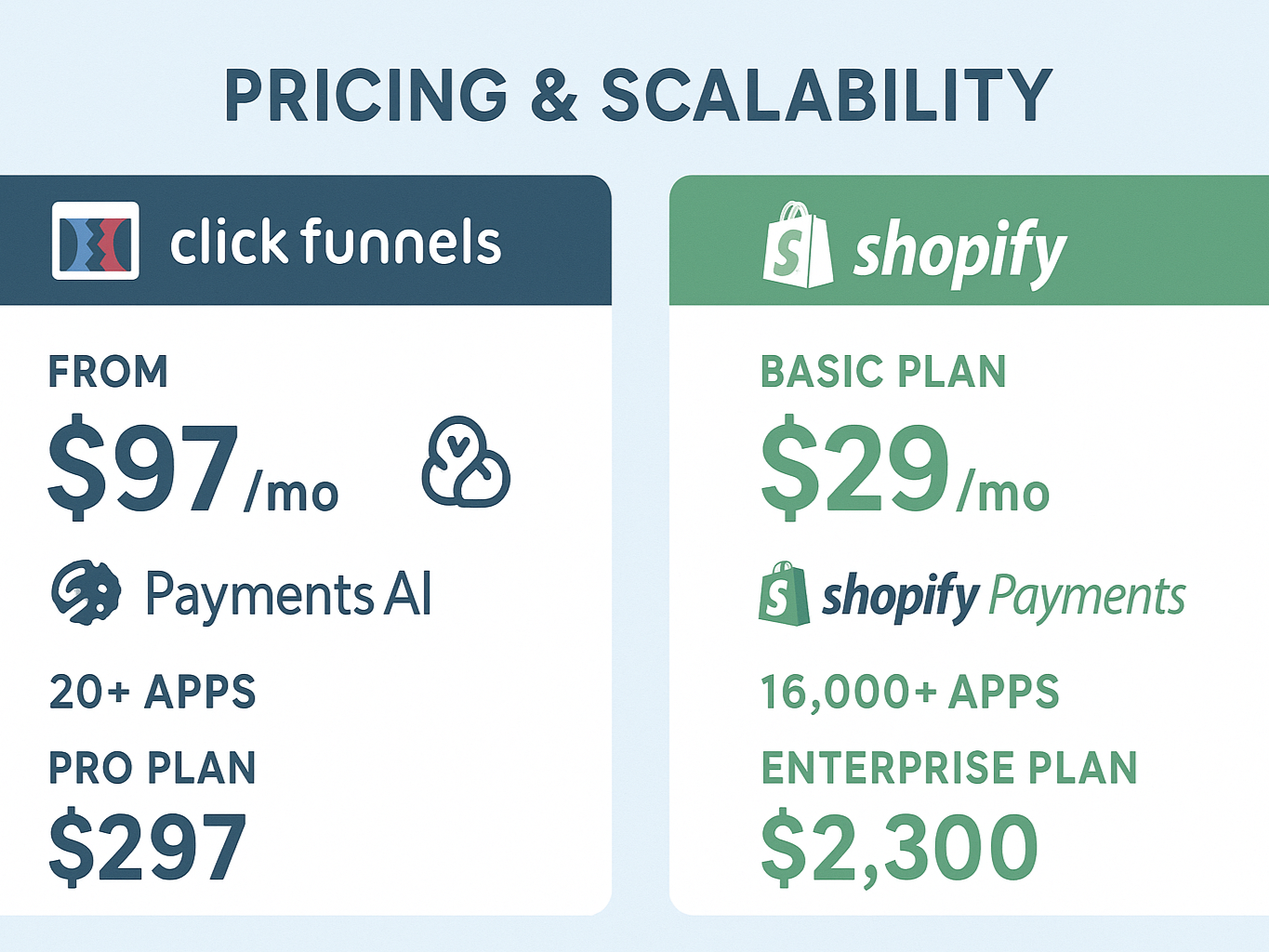
Cost considerations and growth potential play crucial roles in selecting the right platform for your business. Looking beyond features, let’s examine the financial and scaling aspects of ClickFunnels vs Shopify.
1. Plan Comparison: $97 vs $29 starting
First and foremost, Shopify offers a more accessible entry point with its Basic plan priced at $29 per month. It contrasts sharply with ClickFunnels’ Startup plan, which begins at $97 per month. For budget-conscious entrepreneurs, this $68 monthly difference represents a substantial saving.
Both platforms provide discounts with annual commitments, though the Clickfunnel vs Shopify conversion rate potential should factor into your ROI calculations. Shopify offers a 25% discount on yearly plans, bringing the Basic plan down to $21.75 per month. Similarly, ClickFunnels offers a 16% discount on annual billing, bringing the Startup plan to $67.50 per month.
2. Transaction Fees: Payments AI vs Shopify Payments
Regarding payment processing, ClickFunnels utilizes its proprietary Payments AI system, which incurs a standard fee of 2.9% + 30¢ per transaction. While supporting over 110 payment types, using third-party processors like Stripe or PayPal incurs an additional 1% transaction fee.
By comparison, Shopify integrates with over 300 payment gateways. Using third-party processors results in fees ranging from 0.6% to 2% depending on your plan. Consequently, many merchants opt for Shopify Payments, which eliminates these additional charges and offers rates between 2.5% + 30¢ and 2.9% + 30¢ for online sales.
3. App Store Size: 20+ vs 16,000+ apps
In terms of extendability, the difference is striking. Shopify boasts an impressive marketplace with over 16,000 apps covering every imaginable e-commerce need—ranging from marketing tools to inventory management solutions —allowing for extensive customization.
ClickFunnels’ app store, in contrast, contains merely 20 applications. Though limited, these focus on sales-specific integrations with email platforms like GetResponse and collaboration tools like Slack.
4. Scalability: Shopify Plus vs ClickFunnels Pro
For growing businesses, Shopify Plus provides an enterprise-grade solution starting at $2,300 per month. This premium option includes advanced security features, dedicated APIs, enhanced fulfillment capabilities, and marketing automation. Professional implementation often requires expert assistance from Shopify experts in Houston or Shopify developers in Phoenix to maximize the platform’s potential and ensure a successful deployment.
In the Shopify vs ClickFunnels 2.0 pricing battle, ClickFunnels’ Pro plan costs $297 per month. It expands your capacity from 3 to 10 brand workspaces, increasing the number of user accounts from 3 to 10. While more affordable than Shopify Plus, it lacks the extensive enterprise features that high-volume merchants require for sustained growth and success.
Comparison Table: Clickfunnels vs Shopify
| Feature/Aspect | ClickFunnels | Shopify |
| User Base | 110,000 users worldwide | 4.2+ million stores across 175 countries |
| Starting Price | $97/month | $29/month |
| Annual Discount | 16% ($81/month) | 25% ($21.75/month) |
| Core Focus | Sales funnel optimization & lead generation | Complete e-commerce & store management |
| Product Variants | 343 variants per product | 100 variants (increasing to 2000 in 2025) |
| Digital File Size Limit | 3GB | 5GB |
| Funnel Templates | 14+ ready-made templates | Requires third-party apps |
| A/B Testing | Built-in | Requires third-party apps |
| Email Marketing | $0.67 per 1,000 emails | 10,000 free emails/month, then $1.00 per 1,000 |
| Transaction Fees | 2.9% + 30¢ (+ 1% for third-party) | 2.5-2.9% + 30¢ (Shopify Payments) |
| App Store Size | 20+ apps | 16,000+ apps |
| POS Integration | Not available | Built-in POS functionality |
| Affiliate System | Built-in | Requires third-party apps |
| Typical Conversion Rate | 1-5% (up to 10%+) | 1-3% (Shopify reports top stores at 3.2% to 4.8%+) |
| Enterprise Plan | Pro: $297/month | Plus: $2,300/month |
Conclusion
When asking what is better, Clickfunnels vs Shopify, remember that both platforms cater to different business needs. ClickFunnels specializes in sales funnels and upsells, making it ideal for digital products or small catalogs. Shopify, on the other hand, is perfect for selling physical goods, managing extensive inventories, and facilitating international shipping. Your choice depends on whether you prioritize funnel conversions or full-scale store management.
ClickFunnels offers higher conversion rates (1–5%) but starts at $97/month and includes limited app integrations. Shopify is more budget-friendly at $29/month, with over 16,000 apps and no extra transaction fees when using Shopify Payments. Each platform has a different transaction structure, favoring different business strategies.
Some businesses even combine both tools, using Shopify for product fulfillment and ClickFunnels for marketing. This hybrid model can maximize results. In the end, what is better, Clickfunnels vs Shopify, depends on your business goals: streamlined funnels with affiliate features or scalable e-commerce with POS and shipping integrations.
FAQs on clickfunnels vs shopify
Q1. What is the primary focus of ClickFunnels?
ClickFunnels is built for lead generation, sales funnels, and boosting conversions. In the ClickFunnels vs Shopify comparison, ClickFunnels stands out for guiding users through tailored customer journeys that help increase sales of digital and limited physical products.
Q2. What type of businesses benefit most from Shopify?
Shopify is perfect for businesses selling physical products at scale. In the ClickFunnels vs Shopify debate, Shopify excels at inventory management, product variations, and international shipping thanks to its robust e-commerce infrastructure.
Q3. How do ClickFunnels and Shopify differ in terms of funnel creation?
In the ClickFunnels vs Shopify comparison, ClickFunnels offers pre-built funnels with drag-and-drop features, making it an ideal choice for marketers. Shopify lacks native funnel-building tools and requires third-party apps to create similar sales sequences or checkout flows.
Q4. What are the starting prices for ClickFunnels and Shopify?
ClickFunnels starts at $97/month, whereas Shopify begins at $29/month. Comparing Clickfunnels vs Shopify, Shopify becomes even more affordable with its 25% annual discount, bringing the cost down to $21.75/month for the Basic plan.
